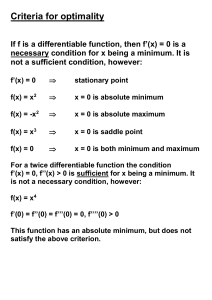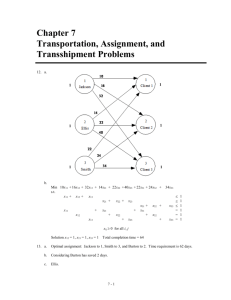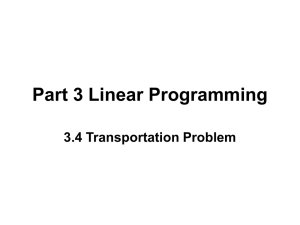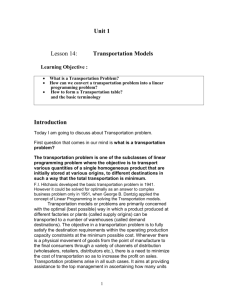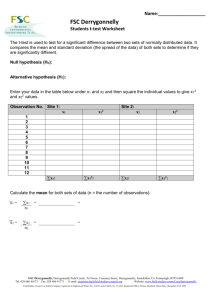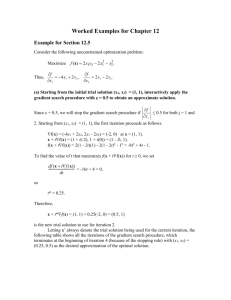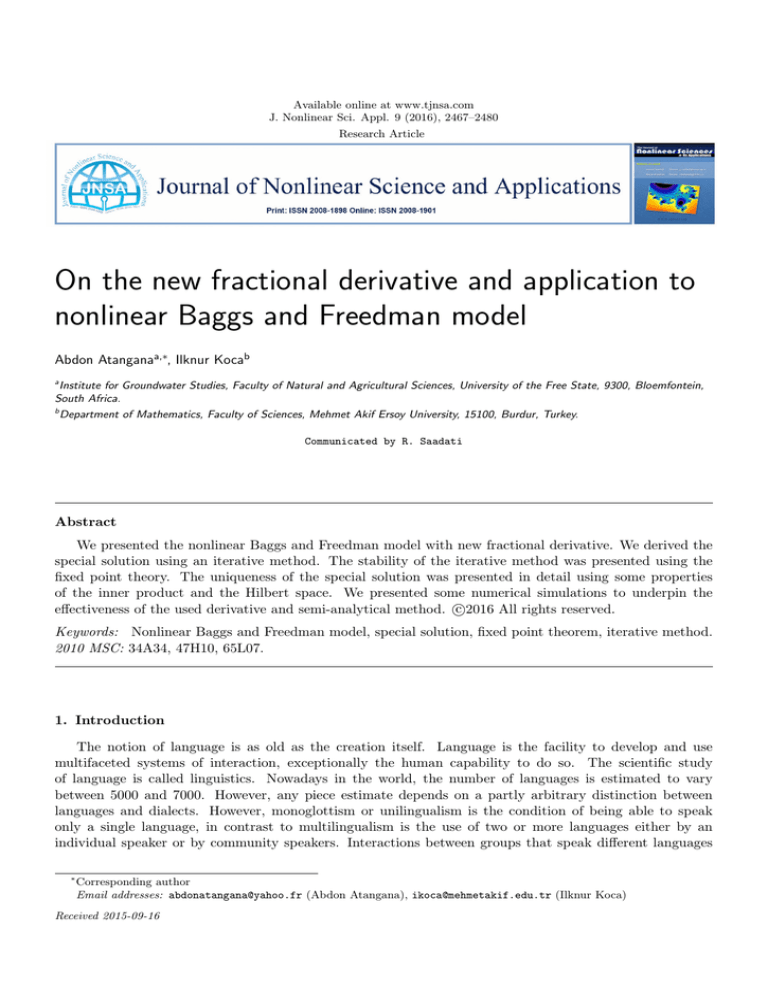
Available online at www.tjnsa.com
J. Nonlinear Sci. Appl. 9 (2016), 2467–2480
Research Article
On the new fractional derivative and application to
nonlinear Baggs and Freedman model
Abdon Atanganaa,∗, Ilknur Kocab
a
Institute for Groundwater Studies, Faculty of Natural and Agricultural Sciences, University of the Free State, 9300, Bloemfontein,
South Africa.
b
Department of Mathematics, Faculty of Sciences, Mehmet Akif Ersoy University, 15100, Burdur, Turkey.
Communicated by R. Saadati
Abstract
We presented the nonlinear Baggs and Freedman model with new fractional derivative. We derived the
special solution using an iterative method. The stability of the iterative method was presented using the
fixed point theory. The uniqueness of the special solution was presented in detail using some properties
of the inner product and the Hilbert space. We presented some numerical simulations to underpin the
c
effectiveness of the used derivative and semi-analytical method. 2016
All rights reserved.
Keywords: Nonlinear Baggs and Freedman model, special solution, fixed point theorem, iterative method.
2010 MSC: 34A34, 47H10, 65L07.
1. Introduction
The notion of language is as old as the creation itself. Language is the facility to develop and use
multifaceted systems of interaction, exceptionally the human capability to do so. The scientific study
of language is called linguistics. Nowadays in the world, the number of languages is estimated to vary
between 5000 and 7000. However, any piece estimate depends on a partly arbitrary distinction between
languages and dialects. However, monoglottism or unilingualism is the condition of being able to speak
only a single language, in contrast to multilingualism is the use of two or more languages either by an
individual speaker or by community speakers. Interactions between groups that speak different languages
∗
Corresponding author
Email addresses: abdonatangana@yahoo.fr (Abdon Atangana), ikoca@mehmetakif.edu.tr (Ilknur Koca)
Received 2015-09-16
A. Atangana, I. Koca, J. Nonlinear Sci. Appl. 9 (2016), 2467–2480
2468
are occurring continuously in all nations in the world due to globalization. Throughout history, in countries
and communities all over the world, populations from different language groups have been constantly coming
into contact, for many reasons including tourism, colonisation, religions, trades, marriages, sport activities,
researcher collaborations and other. This contact can be between, Cameroonian and Turkish as it is now
in some research collaborations, Chinese, English and French as it is observed in Cameroon and other
part of Africa. In order to perfect the interaction between these groups, the need for common language of
communication has led in each case to some more degree of bilingualism or even multilingualism. Nowadays,
there is a whole course about languages interpretation. Top factors that increase the need of bilingualism
are perhaps industrialization, migration, research, sport and urbanization.
A mathematical model portraying the dynamics of interactions between bilingual components and a
monolingual component of a population in a particular environment was proposed in [2, 10]. In [2], the
authors investigated the condition under which both components of population will approach a unique and
steady state. Also they presented the condition under which the bilingual component could persist and
conditions under which it could become extinct. Authors have generalized this model within the scope of
derivative with fractional order [8]. However, these models do not take into account the degree of interest
in time and also the memory of the interaction, meaning the recall of the original meeting or interaction
or contact up to a particular period of time in the present. The weakness of the proposed model using the
concept of derivative with fractional order is the memory effect of the interaction, because of the design of
the derivative, which faces singularity at the end of interval when tracing the history. Recently, Caputo and
Fabrizio proposed a derivative with fractional order with no singular kernel. This derivative has therefore an
advantage over the old Caputo derivative because the full effect of the memory can be portrayed [4, 5]. In this
paper, we further investigate the dynamics of interactions between bilingual components and a monolingual
component of a population in a particular environment using the newly proposed derivative.
The dynamics of interactions between a bilingual component and a monolingual component of a population in a particular environment is presented in mathematical formulas as follow
dx1
x1 (t)x2 (t)
=(B 1 −D1 −H 1 )x1 (t) − L1 x21 (t) − α1
+P 1 B2 x2 (t),
dt
1 + x1 (t)
dx2
x1 (t)x2 (t)
=(B 2 −D2 −H 2 )x2 (t) − L2 x22 (t) + α1
−P 1 B2 x2 (t).
dt
1 + x1 (t)
(1.1)
In this system, Bi and Di + Li xi are the specific birth rate and death rate of xi . 0 < |Hi | ≤ 1 is emigration
parameter for i = 1, 2. 0 < P1 ≤ 1 is infant language acquisition parameter, that proportion of births in the
x2 population raised unilingually. 0 < α1 ≤ 1 is the non-infant language acquisition rate, the proportion of
x1 learning the x2 language per unit time after infancy.
2. Information about the Caputo-Fabrizio derivative with fractional order
Definition 2.1 ([4]). Let f ∈ L1 (a, b), b > a, α ∈ [0, 1] then the new Caputo time derivative of fractional
order is defined as:
Zt
M (α)
t−x
0
α
f (x) exp −α
Dt (f (t)) =
dx,
(2.1)
1−α
1−α
a
where M (α) is a normalization function such that M (0) = M (1) = 1. But, if the function does not belongs
to L1 (a, b) then, the derivative can be reformulated as
Dtα (f (t))
αM (α)
=
1−α
Zt
a
t−x
(f (t) − f (x)) exp −α
dx.
1−α
(2.2)
A. Atangana, I. Koca, J. Nonlinear Sci. Appl. 9 (2016), 2467–2480
Remark 2.2. The instigators observed that, if σ =
derivative of fractional order assumes the form
Dtσ (f (t))
N (σ)
=
σ
Zt
1−α
α
2469
∈ [0, ∞), α =
1
1+σ
∈ [0, 1], then new Caputo
t−x
f (x) exp −
dx, N (0) = N (∞) = 1.
σ
0
(2.3)
a
In addition,
1
t−x
= δ(x − t).
exp −
σ→0 σ
σ
lim
At this instant subsequent to the preface of the novel derivative, the connected anti-derivative turns out
to be imperative; the connected integral of the derivative was proposed by Nieto and Losada.
Definition 2.3 ([5]). Let 0 < α < 1. The fractional integral of order α of a function f is defined by
CF t
Iα (f (t))
2(1 − α)
2α
=
u(t) +
(2 − α)M (α)
(2 − α)M (α)
Zt
u(s)ds, t ≥ 0.
(2.4)
0
We have the following relation.
Remark 2.4. Note that, according to the above definition, the fractional integral of Caputo type of function
of order 0 < α < 1 is an average between function f and its integral of order one [5]. This therefore imposes
2α
2(1 − α)
+
= 1.
(2 − α)M (α) (2 − α)M (α)
(2.5)
The above expressions yields an explicit formula for
M (α) =
2
, 0 ≤ α ≤ 1.
(2 − α)
Because of the above, Nieto and Losada proposed that the new Caputo derivative of order 0 < α < 1 can
be reformulated as
Zt
1
α
0
CF α
D∗ f (t) =
exp −
(t − s) f (s)ds, t ≥ 0.
(2.6)
1−α
1−α
0
3. Equilibrium points of system and asymptotic stability
Let consider the model with Caputo-Fabrizio derivative and α satisfying 0 < α ≤ 1 below:
CF α
0 Dt X1 (t)=(B 1 −D 1 −H 1 )X 1 (t)
−α1
X1 (t)X2 (t)
+P 1 B2 X2 (t),
1 + X1 (t)
CF α
0 Dt X2 (t)=(B 2 −D 2 −H 2 )X 2 (t)
+α1
− L1 X12 (t)
− L2 X22 (t)
(3.1)
X1 (t)X2 (t)
−P 1 B2 X2 (t),
1 + X1 (t)
where 0 < Bi ≤ 1, 0 < Di ≤ 1, 0 < |Hi | ≤ 1 are the birth, death and emigration parameters for i = 1, 2.
The model describes the interaction of a majority unilingual population with X1 and a bilingual population
1 (t)X2 (t)
with X2 . The term α1 X1+X
describes that part of population X1 lost to X2 due to virtual predation on
1 (t)
the part of X2 .
A. Atangana, I. Koca, J. Nonlinear Sci. Appl. 9 (2016), 2467–2480
Let α ∈ (0, 1] and consider the system
CF
α
0 Dt X1 (t)
CF D α X (t)
2
t
0
2470
= f1 (X1 , X2 ),
= f2 (X1 , X2 ),
with the initial values X1 (0) = X01 and X2 (0) = X02 .
1 (t)X2 (t)
Here f1 (X1 , X2 ) = (B1 − D1 − H1 )X1 (t) − L1 X12 (t) − α1 X1+X
+ P1 B2 X2 (t) and
1 (t)
f2 (X1 , X2 ) = (B2 − D2 − H2 )X2 (t) − L2 X22 (t) + α1
X1 (t)X2 (t)
− P1 B2 X2 (t).
1 + X1 (t)
To evaluate the equilibrium points let fi (X1 , X2 ) = 0, i = 1, 2 then the equilibrium points are E0 (0, 0)
and E1 (X1∗ , X2∗ ), where
(B2 − D2 − H2 )X2∗ − L2 X22∗ − P1 B2 X2∗
,
L2 X22∗ + P1 B2 X2∗ − α1 X2∗ − (B2 − D2 − H2 )X2∗
(B1 − D1 − H1 )X1∗ − L1 X12∗
X2∗ =
.
X∗
α1 1+X1 ∗ − P1 B2
X1∗ =
1
Lack of population equilibrium for the system is E0 = (0, 0) and the Jacobian matrix at this point is given
below:
(B1 − D1 − H1 )
P1 B2
J(E0 ) =
.
0
(B2 − D2 − H2 ) − P1 B2
Theorem 3.1. Lack of population equilibrium of the system (3.1) is asymptotic stable if
(B1 − D1 − H1 ) ((B2 − D2 − H2 ) − P1 B2 ) > 0.
Proof. The equilibrium point of the system (3.1) is asymptotic stable if all the eigenvalues, λi , i = 1, 2 of
J(E0 ) satisfy the following conditions [1]-[6]
|arg λi | >
απ
.
2
(3.2)
To find the eigenvalues of system, let solve the following characteristic equation below
det(J(E0 ) − λI) = 0.
Thus, we have the following equation
λ2 − (A + B)λ + AB = 0,
where
A = (B1 − D1 − H1 ),
B = (B2 − D2 − H2 ) − P1 B2 .
If AB > 0, then the condition given by (3.2) is satisfied. This completes the proof of Theorem 3.1.
We now discuss the asymptotic stability of the E1 (X1∗ , X2∗ ) equilibrium of the system given by (3.1).
The Jacobian matrix J(E1 ) evaluated at the equilibrium is given by
(B1 − D1 − H1 )
∗
X
X2∗
−2L X ∗ − α
−α1 1+X1 ∗ + P1 B2
1 1
1
1
∗ 2
1+X
(
)
,
1
J(E 1 ) =
(B2 − D2 − H2 )
X2∗
∗
α1
X1
2
∗
∗
−2L2 X2 + α1 1+X ∗ − P1 B2
(1+X1 )
1
A. Atangana, I. Koca, J. Nonlinear Sci. Appl. 9 (2016), 2467–2480
2471
so the characteristic equation of the linearized system is of the form
λ2 − (c + d)λ + cd − kl = 0,
where
X2∗
,
(1 + X1∗ )2
X1∗
d = (B2 − D2 − H2 ) − 2L2 X2∗ + α1
− P1 B2 ,
1 + X1∗
X2∗
,
k = α1
(1 + X1∗ )2
X1∗
l = −α1
+ P1 B2 .
1 + X1∗
c = (B1 − D1 − H1 ) − 2L1 X1∗ − α1
(3.3)
Theorem 3.2. Let c, d, k and l be as given in (3.3). If (c + d) < 0 and cd < kl is satisfied then the
equilibrium point E1 (X1∗ , X2∗ ) of the system (3.1) is unstable.
Proof. If (c + d) < 0 and cd < kl is satisfied, from Descartes rule of signs, it is clear that the characteristic
equation has at least one positive real root. So, the equilibrium point E1 (X1∗ , X2∗ ) of the system (3.1) is
unstable.
4. Solution of nonlinear Baggs and Freedman model with Caputo-Fabrizio derivative
First we give the following useful definition of Sumudu transform. The Sumudu transform, an integral
transform similar to the Laplace transform, introduced in the early 1990s by Watugala [9] to solve differential
equations and control engineering problems is given below:
Definition 4.1. The Sumudu transform of a function f (t), defined for all real numbers t ≥ 0, is the function
Fs (u), defined by
Z∞
1
−t
S(f (t)) = Fs (u) =
exp[ ]f (t)dt.
u
u
0
4.1. Derivation of the special solution
The following model is considered using the Caputo-Fabrizio fractional derivative below
CF α
0 Dt X1 (t)=(B 1 −D 1 −H 1 )X 1 (t)
−α1
X1 (t)X2 (t)
+P 1 B2 X2 (t),
1 + X1 (t)
CF α
0 Dt X2 (t)=(B 2 −D 2 −H 2 )X 2 (t)
+α1
− L1 X12 (t)
− L2 X22 (t)
(4.1)
X1 (t)X2 (t)
−P 1 B2 X2 (t).
1 + X1 (t)
The aim of this section is to provide a special solution of the above equation applying the Sumudu transform
on both sides of equation (4.1) together with an iterative method. We shall give the Sumudu transform in
the following theorem.
Theorem 4.2. Let f (t) be a function for which the Caputo-Fabrizio exists, then the Sumudu transform of
the Caputo-Fabrizio fractional derivative of f (t) is given as:
ST
CF α
0 Dt
((f (t)) = M (α)
S(f (t)) − f (0)
.
1 − α + αu
A. Atangana, I. Koca, J. Nonlinear Sci. Appl. 9 (2016), 2467–2480
2472
To solve the above equation (4.1), we apply the Sumudu transform on both sides of equation (4.1), we
obtain
(B1 − D1 − H1 )X1 − L1 X12
S(X1 (t)) − X1 (0)
,
M (α)
=S
1 X2
−α1 X
1 − α + αs
1+X1 + P1 B2 X2
(4.2)
(B2 − D2 − H2 )X2 − L2 X22
S(X2 (t)) − X2 (0)
M (α)
.
=S
1 X2
+α1 X
1 − α + αs
1+X1 − P1 B2 X2
Rearranging, we obtain
S(X1 (t)) =X1 (0)
(1 − α + αs)
+
S
M (α)
(B1 − D1 − H1 )X1 − L1 X12
1 X2
−α1 X
1+X1 + P1 B2 X2
(B2 − D2 − H2 )X2 − L2 X22
1 X2
+α1 X
1+X1 − P1 B2 X2
,
(4.3)
S(X2 (t)) =X2 (0)
(1 − α + αs)
+
S
M (α)
.
Now applying the inverse Sumudu transform on both sides of equation (4.3), we obtain;
X1 (t) =X1 (0)
+S
−1
(1 − α + αs)
S
M (α)
(1 − α + αs)
S
M (α)
(B1 − D1 − H1 )X1 − L1 X12
1 X2
−α1 X
1+X1 + P1 B2 X2
(B2 − D2 − H2 )X2 − L2 X22
1 X2
+α1 X
1+X1 − P1 B2 X2
,
(4.4)
X2 (t) =X2 (0)
+S
−1
.
We next obtain the following recursive formula;
X1(n+1) (t) =X1(n) (0)
+ S −1
(1 − α + αs)
S
M (α)
2
(B1 − D1 − H1 )X1(n) − L1 X1(n)
−α1
X1(n) X2(n)
1+X1(n)
!!
,
+ P1 B2 X2(n)
(4.5)
X2(n+1) (t) =X2(n) (0)
+ S −1
(1 − α + αs)
S
M (α)
2
(B2 − D2 − H2 )X2(n) − L2 X2(n)
+α1
X1(n) X2(n)
1+X1(n)
− P1 B2 X2(n)
!!
,
and the solution of (4.1) is provided by
X1 (t) = lim X1(n) (t),
n→∞
X2 (t) = lim X2(n) (t).
n→∞
4.2. Application of fixed-point theorem for stability analysis of iteration method
Let (X, k.k) be a Banach space and H a self-map of X. Let yn+1 = g(H, yn ) be particular recursive
procedure. Suppose that, F (H) the fixed-point set of H has at least one element and that yn converges to a
point p ∈ F (H). Let {xn } ⊂X and define en = kxn+1 − g(H, xn )k . If lim en = 0 implies that lim xn = p,
n→∞
n→∞
then the iteration method yn+1 = g(H, yn ) is said to be H-stable. Without any loss of generality, we
A. Atangana, I. Koca, J. Nonlinear Sci. Appl. 9 (2016), 2467–2480
2473
must assume that, our sequence {xn } has an upper boundary; otherwise we cannot expect the possibility
of convergence. If all these conditions are satisfied for yn+1 = Hyn which is known as Picard’s iteration,
consequently the iteration is H-stable. We shall then state the following theorem.
Theorem 4.3 ([7]). Let (X, k.k) be a Banach space and H a self-map of X satisfying
kHx − Hy k ≤ C kx − Hx k + c kx − yk ,
for all x, y in X where 0 ≤ C, 0 ≤ c < 1. Suppose that H is Picard H-Stable .
Let us take into account the following recursive formula equation (4.5) connected to equation (3.1).
X1(n+1) (t) =X1(n) (0)
+ S −1
e2
(B1 − D1 − H1 )X1(n) − L1 X
1(n)
1 + (s − 1) α
S
M (α)
−α1
X1(n) X2(n)
1+X1(n)
!!
,
+ P1 B2 X2(n)
(4.6)
X2(n+1) (t) =X2(n) (0)
+S
where
1+(s−1)α
M (α)
−1
e2
(B2 − D2 − H2 )X2(n) − L2 X
2(n)
1 + (s − 1) α
S
M (α)
+α1
X1(n) X2(n)
1+X1(n)
− P1 B2 X2(n)
!!
,
e2 , X
e2
is the fractional Lagrange multiplier and X
1(n)
2(n) are restricted variation implying
e2 = δ X
e2 .
δX
1(n)
2(n)
Theorem 4.4. Let T be a self-map defined as
T (X1(n) (t)) =X1(n+1) (t) = X1(n) (t)
+S
−1
2
(B1 − D1 − H1 )X1(n) − L1 X1(n)
1 + (s − 1) α
S
M (α)
−α1
X1(n) X2(n)
1+X1(n)
!!
,
+ P1 B2 X2(n)
(4.7)
T (X2(n) (t)) =X2(n+1) (t) = X2(n) (t)
+S
−1
2
(B2 − D2 − H2 )X2(n) − L2 X2(n)
1 + (s − 1) α
S
M (α)
+α1
X1(n) X2(n)
1+X1(n)
− P1 B2 X2(n)
!!
,
then the iteration is T −stable in L1 (a, b) if
!
1 + (B1 − D1 − H1 )f (γ) − L1 X1(n) + X1(m) g (γ)
< 1,
−α1 (CA+C+K)
h(γ) − P1 B2 k(γ)
MN
!
1 + (B2 − D2 − H2 )j(γ) − L2 X2(n) + X2(m) p (γ)
< 1,
+α1 (CA+C+K)
s(γ) − P1 B2 L(γ)
MN
where f, g, h, k are functions from S −1
n
1+(s−1)α
M (α) S
o
(4.8)
.
Proof. The fist step of the proof consists of showing that T has a fixed point. To achieve this, we evaluate
the following for all (n, m) ∈ N × N.
A. Atangana, I. Koca, J. Nonlinear Sci. Appl. 9 (2016), 2467–2480
T (X1(n+1) , X2(n+1) ) − T (X1(m+1) , X2(m+1) )
X1(n+1) − X1(m+1) = X1(n) − X1(m) +
(B1 − D1 −
H1 ) X1(n) − X
1(m)
n
o
2
2
−L1 X1(n)
− X1(m)
−1 1+(s−1)α S
X1(m) X1(n) X2(n) − X2(m)
S
M (α)
+X
X
−
X
+
X
X
−
X
1(n)
2(n)
2(m)
2(m)
1(n)
1(m)
−α1
(1+X
1(n) )(1+X1(m) )
+P1 B2 X2(n) − X2(m)
=
X2(n+1) − X2(m+1) = X2(n)
− X2(m) +
(B
−
D
−
H
)
X2(n) − X
2
2
2
n
o 2(m)
2
2
−L
X
−
X
2
2(n)
2(m)
1+(s−1)α
−1
X
X
X
−
X
1(m)
1(n)
2(n)
2(m)
S
S
M (α)
+X1(n) X2(n) − X2(m) + X2(m) X1(n) − X1(m)
+α1
(1+X
1(n) )(1+X1(m) )
−P1 B2 X2(n) − X2(m)
2474
(4.9)
.
Now applying norm on both sides and without loss of generality
X1(n+1) − X1(m+1) X1(n) − X1(m) +
(B
H
)
X
−
X
1 − D1 −
1
1(n)
1(m)
n
o
2
2
−L1 X1(n)
− X1(m)
= −1 1+(s−1)α
X1(m) X1(n) X2(n) − X2(m)
S M (α) S
−α +X1(n) X2(n) − X2(m) + X2(m) X1(n) − X1(m)
1
(1+X
1(n) )(1+X1(m) )
+P1 B2 X
−X
2(n)
2(m)
,
(4.10)
using the properties of the norm in particular the triangular inequality, the right hand side of equation (4.10)
is converted to
X
−
X
+
1(n)
1(m)
(B1 − D1 −
o 1(m)
n H1 ) X1(n) − X
2
2
−L1 X1(n)
− X1(m)
X1(m) X1(n)
X2(n) − X2(m)
−1 1+(s−1)α
S M (α) S
+X1(n) X2(n) − X2(m)
+X
X
−
X
2(m)
1(n)
1(m)
−α
1
(1+X
1(n) )(1+X1(m) )
+P1 B2 X2(n) − X2(m)
(4.11)
X1(n) − X1(m) +
(B1 − D1 −
n H1 ) X1(n) − X
o 1(m)
2
2
−L
X
−
X
1
1(n)
1(m)
1 + (s − 1) α
X1(m) X1(n)
−1
X2(n) − X2(m)
S
S
,
+X1(n) X2(n) − X2(m)
M (α)
+X2(m) X1(n) − X1(m)
−α
1
1+X1(m) )
(1+X
)(
1(n)
+P1 B2 X2(n) − X2(m)
A. Atangana, I. Koca, J. Nonlinear Sci. Appl. 9 (2016), 2467–2480
using further the linearity of the inverse Sumudu transform, we obtain the following
≤ X1(n) − X1(m) −1 1 + (s − 1) α
+S
S (B1 − D1 − H1 ) X1(n) − X1(m) M (α)
o
n
−1 1 + (s − 1) α
2
2
+S
S −L1 X1(n) − X1(m) M (α)
X
X
X
−
X
1(m)
1(n)
2(n)
2(m)
+X1(n) X2(n) − X2(m)
1 + (s − 1) α
+X2(m) X1(n) − X1(m)
+ S −1
S −α1
M (α)
1 + X1(n) 1 + X1(m)
1 + (s − 1) α S P1 B2 X2(n) − X2(m) .
+ S −1
M (α)
2475
(4.12)
Since both the solutions play the same role, we shall assume in this case that
X2(n) − X2(m) ∼
= X1(n) − X1(m) .
Replacing this in equation (4.12), we obtain the following relation
≤ X1(n) − X1(m) 1 + (s − 1) α + S −1
S (B1 − D1 − H1 ) X1(n) − X1(m) M (α)
n
o
−1 1 + (s − 1) α
2
2
+S
S −L1 X1(n) − X1(m) M (α)
X1(m) X1(n)
X1(n) − X1(m)
+X1(n) X1(n) − X1(m)
1 + (s − 1) α
+X2(m) X1(n) − X1(m)
S −α1
+ S −1
M (α)
1 + X1(n) 1 + X1(m)
1 + (s − 1) α S P1 B2 X1(n) − X1(m) .
+ S −1
M (α)
(4.13)
Since X1(n) , X1(m) are bounded, we can find five different positive constants, C, M, A, N, K such that for
all t.
X1(n) <C, X1(m) < A, 1 + X1(n) < M ,
(4.14)
1 + X1(m) <N , X2(m) < K, (n, m) ∈ N × N.
Now considering equation (4.13) with (4.14), we obtain the following
T X1(n) − T X1(m) !
1 + (B1 − D1 − H1 )f (γ) − L1 X1(n) + X1(m) g (γ) X1(n) − X1(m) ,
≤
(CA+C+K)
h(γ) − P1 B2 k(γ)
−α1
MN
(4.15)
A. Atangana, I. Koca, J. Nonlinear Sci. Appl. 9 (2016), 2467–2480
where f, g, h, k are functions from S −1
1+(s−1)α
M (α) S
2476
. In the same way, we get
T X2(n) − T X2(m) ≤
for
and
!
1 + (B2 − D2 − H2 )j (γ) − L2 X2(n) + X2(m) p (γ) X2(n) − X2(m) (CA+C+K)
+α1
s(γ) − P1 B2 L(γ)
MN
(4.16)
!
1 + (B1 − D1 − H1 )f (γ) − L1 X1(n) + X1(m) g (γ)
<1
−α1 (CA+C+K)
h(γ) − P1 B2 k(γ)
MN
!
1 + (B2 − D2 − H2 )j(γ) − L2 X2(n) + X2(m) p (γ)
< 1.
+α1 (CA+C+K)
s(γ) − P1 B2 L(γ)
MN
Then the nonlinear T -self mapping has a fixed point. We next show that, T satisfies the conditions in
Theorem 4.3. Let (4.15)-(4.16) be held thus putting
X1(n) + X1(m) g (γ)
1
+
(B
−
D
−
H
)f
(γ)
−
L
1
1
1
1
−α1 (CA+C+K)
h(γ) −
MN
P1 B2 k(γ), c = (0, 0), C =
(4.17)
X2(n) + X2(m) p (γ)
1
+
(B
−
D
−
H
)j(γ)
−
L
2
2
2
2
s(γ) − P1 B2 L(γ),
+α1 (CA+C+K)
MN
then the above shows that the inequality of Theorem 4.3 holds for the nonlinear mapping T . Therefore since
all conditions in Theorem 4.3 hold for the defined non-linear mapping T , then T is Picards T −stable. This
completes the proof of Theorem 4.4.
5. Uniqueness of the special solution
In this section, we show that the special solution of equation (1.1) is unique using the iteration method.
We shall first assume that, equation (1.1) has an exact solution via which, the special solution converges for
a large number m. We consider the following Hilbert space H = L2 ((a, b) × (0, T )) that can be defined as
the set of those functions.
ZZ
v : (a, b) × [0, T ] → R,
uvdudv < ∞.
We now, consider the following operator
(
1 (t)X2 (t)
(B1 − D1 − H1 )X1 (t) − L1 X12 (t) − α1 X1+X
+ P1 B2 X2 (t),
1 (t)
T (X1 , X2 ) =
X1 (t)X2 (t)
2
(B2 − D2 − H2 )X2 (t) − L2 X2 (t) + α1 1+X1 (t) − P1 B2 X2 (t).
(5.1)
The aim of this part is to prove that the inner product of
(T (X11 − X12 , X21 − X22 ), (w1 , w2 )) ,
(5.2)
where (X11 − X12 ) , (X21 − X22 ) are special solution of system. However,
(T (X11 − X12 , X21 − X22 ), (w1 , w2 ))
!
(B1 − D1 − H1 ) (X11 − X12 ) − L1 (X11 − X12 )2
,
−X12 )(X21 −X22 )
−α1 (X111+(X
+ P1 B2 (X21 − X22 ) , w1
11 −X12 )
!
=
(B2 − D2 − H2 ) (X21 − X22 ) − L2 (X21 − X22 )2
.
+α1 (X11 −X12 )(X21 −X22 ) − P1 B2 (X21 − X22 ) , w2
1+(X11 −X12 )
(5.3)
A. Atangana, I. Koca, J. Nonlinear Sci. Appl. 9 (2016), 2467–2480
2477
We shall evaluate the first equation in the system without loss of generality
!
(B1 − D1 − H1 ) (X11 − X12 ) − L1 (X11 − X12 )2
−X12 )(X21 −X22 )
−α1 (X111+(X
+ P1 B2 (X21 − X22 ) , w1
11 −X12 )
= ((B1 − D1 − H1 ) (X11 − X12 ) , w1 ) + −L1 (X11 − X12 )2 , w1
−X12 )(X21 −X22 )
+ −α1 (X111+(X
,
w
1 + (P1 B2 (X21 − X22 ) , w1 ) .
11 −X12 )
(5.4)
Since both solutions play almost the same role, we can assume that,
X11 − X12 ∼
= X21 − X22 ,
then the equation (5.3) becomes
!
(B1 − D1 − H1 ) (X11 − X12 ) − L1 (X11 − X12 )2
−X12 )(X21 −X22 )
−α1 (X111+(X
+ P1 B2 (X21 − X22 ) , w1
11 −X12 )
2
∼
= ((B1 − D1 − H1 ) (X11 − X12 ) , w1 ) + L1 (X11 − X12 ) , w1
!
(X11 − X12 )2
, w1 + (P1 B2 (X11 − X12 ) , w1 ) .
+ α1
1 + (X11 − X12 )
(5.5)
Nevertheless, using the relationship between the norm and the inner function, we obtain the following
inequality
(B1 − D1 − H1 ) (X11 − X12 ) − L1 (X11 − X12 )2
−X12 )(X21 −X22 )
−α1 (X111+(X
+ P1 B2 (X21 − X22 ) , w1
11 −X12 )
!
≤(B1 − D1 − H1 ) kX11 − X12 k kw1 k + L1 kX11 − X12 k2 kw1 k
kX11 − X12 k2
kw1 k + P1 B2 kX11 − X12 k kw1 k
+ α1
k1 + X11 − X12 k
= (B1 − D1 − H1 ) + L1 w + αk+P1 B2 kX11 − X12 k kw1 k .
(5.6)
Above in equality (5.6),
w = kX11 − X12 k , k = α1
kX11 − X12 k
.
k1 + X11 − X12 k
Using the same routine, the second equation of the system can be evaluated as follows
(B2 − D2 − H2 ) (X21 − X22 ) − L2 (X21 − X22 )2
−X12 )(X21 −X22 )
+α1 (X111+(X
+ P1 B2 (X22 − X21 ) , w2
11 −X12 )
!
≤(H2 + D2 − B2 ) kX22 − X22 k kw2 k + L2 kX22 − X21 k2 kw2 k
kX22 − X21 k2
+ α1
kw2 k + P1 B2 kX22 − X21 k kw2 k
k1 − (X22 − X21 )k
= (H2 + D2 − B2 ) + L2 p + αf + P1 B2 kX22 − X21 k kw2 k .
Above in equality (5.7),
p = kX22 − X21 k , f = α1
kX22 − X21 k
.
k1 − (X22 − X21 )k
(5.7)
A. Atangana, I. Koca, J. Nonlinear Sci. Appl. 9 (2016), 2467–2480
2478
Replacing equation (5.6) and (5.7) into equation (5.3), we obtain
(T (X11 − X12 , X21 − X22 ), (w1 , w2 ))
(B
−
D
−
H
)
1
1
1
kX11 − X12 k kw1 k
+L1 w + α1 k+P1 B2 ≤
(H2 + D2 − B2 )
kX22 − X21 k kw2 k .
+L2 p + α1 f + P1 B2
(5.8)
But, for large number m and n, both solution converge to the exact solution, using the topology concept;
we can find two very small positive parameters ln , lm such that
ln
,
(B1 − D1 − H1 )
kw1 k
+L1 w + α1 k + P1 B2
lm
.
kX2 − X21 k , kX2 − X22 k < (H2 + D2 − B2 )
kw2 k
2
+L2 p + α1 f + P1 B2
kX1 − X11 k , kX1 − X12 k < 2
(5.9)
Thus introducing the exact solution in the right hand side of equation (5.8), using the triangular inequality
and finally taking M = max(n, m), l = max(ln , lm ).
(B1 − D1 − H1 ) + L1 w
kX12 − X11 k kw1 k
+α
k+P
B
l
1
1
2
<
(H2 + D2 − B2 ) + L2 p
l
kX22 − X21 k kw2 k
+α1 f + P1 B2
(5.10)
Since l is a very small positive parameter, we conclude on the based of the topology idea that
(B1 − D1 − H1 ) + L1 w
kX12 − X11 k kw1 k = 0
+α
0
k+P
B
1
1
2
,
<
0
p
(H
+
D
−
B
)
+
L
2
2
2
2
kX22 − X21 k kw2 k = 0
+α1 f + P1 B2
But
(B1 − D1 − H1 ) + L1 w + α1 k+P1 B2 =
6 ,
(H2 + D2 − B2 ) + L2 p + α1 f + P1 B2 6=0,
(5.11)
kw1 k , kw2 k =
6 0⇒
kX11 − X12 k = kX21 − X22 k = 0 ⇒ X11 = X12 , X21 = X22 .
This completes the proof of uniqueness.
6. Numerical solution
We present here the numerical simulation of the special solution of our model as function of time for
different values of alpha. The simulations are depicted in Figures 1–6. Here the blue line represents X1 , the
yellow line represents X2 . It is worth noting that, the prediction depends on the value of alpha also beside
the theoretical parameters.
A. Atangana, I. Koca, J. Nonlinear Sci. Appl. 9 (2016), 2467–2480
Figure 1: Prediction between the two population for alpha
= 0.95
2479
Figure 2: Interaction between the two population for alpha = 0.95
Figure 3: Prediction between the two population for alpha
= 0.65
Figure 4: Interaction between the two population for alpha = 0.65
Figure 5: Prediction between the two population for alpha
= 0.25
Figure 6: Interaction between the two population for alpha = 0.25
7. Conclusion
In order to fully include effect of memory into the model portraying the dynamics of interactions between
a bilingual component and a monolingual component of a population in a particular environment, we used
the newly proposed derivative with fractional order. The design of the definition allows the description of
the memory without any singularity like in the case of Caputo and Riemann-Liouville derivative. With the
benefits of the new derivative, we presented the stability of the equilibrium points. We derived the solution
of the new equation using an iterative scheme. In order to show the efficiency of the used method, we
employed the fixed-point theorem to study the stability analysis of the method for solving the new equation.
A. Atangana, I. Koca, J. Nonlinear Sci. Appl. 9 (2016), 2467–2480
2480
We presented in detail the uniqueness of the special derived solution. Some numerical simulations were
presented.
References
[1] E. Ahmed, A. M. A. El-Sayed, H. A. A. El-Saka, Equilibrium points, stability and numerical solutions of fractionalorder predator-prey and rabies models, J. Math. Anal. Appl., 325 (2007), 542–553. 3
[2] I. Baggs, H. I. Freedman, A mathematical model for the dynamics of interactions between a unilingual and a
bilingual population: Persistence versus extinction, J. Math. Sociology, 16 (1990), 51–75. 1
[3] I. Baggs, H. I. Freedman, W. G. Aiello, Equilibrium characteristics in models of unilingual-bilingual population
interactions, In Ocean Wave Mechanics, Computational Fluid Dynamics, and Mathematical Modeling, (Edited
by M. Rahman), Computational Mechanics Publ., Southampton, (1990), 879–886.
[4] M. Caputo, M. Fabrizio, A new Definition of Fractional Derivative without Singular Kernel, Progr. Fract. Differ.
Appl., 2 (2015), 73–85. 1, 2.1
[5] L. Jorge, J. N. Juan, Properties of a New Fractional Derivative without Singular Kernel, Progr. Fract. Differ.
Appl., 2 (2015), 87–92. 1, 2.3, 2.4
[6] D. Matignon, Stability results for fractional differential equations with applications to control processing, Comput.
Eng. Sys. Appl., France, 2 (1996), 963–968. 3
[7] Z. M. Odibat, S. Momani, Application of variational iteration method to nonlinear differential equation of fractional order, Int. J. Nonlinear Sci. Numer. Simul., 7 (2006), 27–34. 4.3
[8] Y. Sofuoglu, N. Ozalp, Fractional Order Bilingualism Model Without Conversion from Dominant Unilingual
Group to Bilingual Group, Differ. Equ. Dynam. Sys., 2015 (2015), 9 pages. 1
[9] G. K. Watugala, Sumudu transform: a new integral transform to solve differential equations and control engineering problems, Int. J. Math. Education Sci. Tech., 24 (1993), 35–43. 4
[10] E. Witte, H. B. Beardsmore, The Interdisciplinary Study of Urban Bilingualism in Brussels, Multilingual Matters
Ltd., Philadelphia, PA, (1987). 1

